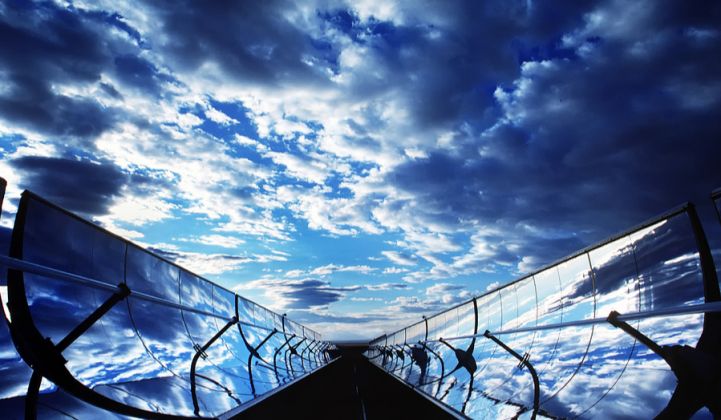One of the world’s largest solar thermal plants is set to come on-line in Morocco -- a rare positive development for the ailing concentrating solar power industry.
This month, the first 160 megawatts (Noor I) of the 580-megawatt Ouarzazate CSP plant will start feeding electricity into Morocco's grid. It’s part of an effort to turn Morocco into a clean energy exporter, possibly even helping to power southern Europe. Ouarzazate is one of a wave of new projects planned for the Middle East and Africa.
Elsewhere, however, high operating costs and suboptimal plant performance -- along with plummeting photovoltaic and natural-gas prices -- have resulted in a freeze on projects in the U.S.
And Abengoa, until recently one of Europe’s leading developers of CSP projects, faces dire financial troubles.
Large-scale solar thermal is in a fragile state, with many development companies looking to alternatives or exiting the space altogether.
Abengoa is unlikely to be one of them.
Jenny Chase, manager for solar insight at Bloomberg New Energy Finance, thinks the Spanish company's likely bankruptcy is a pretty serious blow to the sector, as “it reduces the pool of strong advocates for the technology.”
She also sees the Ouarzazate project as evidence of a shift toward the Middle East and Africa for solar thermal.
Chase expects the Middle East and Africa to be “the main markets for solar thermal in the next 10 years,” but cautions that “this is not saying much.”
The costs for solar thermal are just too high compared to PV, she said.
Tyler Ogden, an analyst with Lux Research, also painted a gloomy picture for the technology. “After strong government support and a lot of hype, large-scale concentrating solar plants continue to disappoint with poor performance. The U.S.’ largest plants have failed to meet the specifications they were built around. Ivanpah is only producing 40 percent of expected electricity,” he said.
BrightSource Energy has disputed this characterization, saying its Ivanpah plant is on track to meet performance metrics after some technical problems. This spring and summer, the plant exceeded expected generation levels.
Ogden said plants are burning large amounts of natural gas to keep their molten salt at an ideal temperature. The corrosive nature of the salt is proving to be a maintenance nightmare, leading to much higher running costs than originally calculated.
Where the molten salt is also used as an energy storage medium in addition to heat transfer, keeping optimal temperatures is a bit easier, said Ogden. He noted that the Ouarzazate plants incorporate energy storage, “potentially making them more attractive.”
The European Investment Bank, World Bank and other international institutions have contributed much of the $9 billion in loans to the Ouarzazate project, backed by Moroccan government guarantees. In addition, state energy subsidies are being introduced to avoid costs being passed on directly to energy customers.
The organization behind the fundraising is ACWA Power, a key player in the rise of solar thermal in the Middle East and Africa. Not only did it put together the consortium that will develop Ouarzazate, but it is also working with SolarReserve on the 100-megawatt Redstone solar thermal project in Northern Cape, South Africa, and it has a presence in eastern Europe and China.
Despite its reach, ACWA is a recent arrival on the scene. Founded in 2004, it is entirely Saudi Arabian-owned and started out in the desalination market. It has since diversified into energy generation -- often to power its own desalination plants.
With Abengoa in trouble, both Chase and Ogden think ACWA could be in a position to pick up the Spanish company's assets.
While the party may be over for CSP in the U.S., Ogden said there could still be “significant investment interest" in the Middle East, China, Africa and South America.



